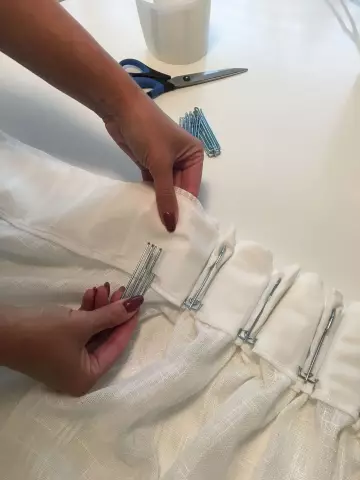Pleating is a knitting pattern that forms even folds like an accordion. It is used as a decoration element for dresses, skirts or the bottom of any product. Ease of execution is a big plus. False loose folds are formed by knitting vertical lines from the purl and front loops, or by removing the loops.

It is necessary
- - knitting needles;
- - yarn.
Instructions
Step 1
First option. Cast on a multiple of 10 stitches and 2 hem stitches. Knit the first (front) row: hem, 9 front and 1 purl. Repeat this sequence until the end of the row. Finish the row with an edge loop. Knit the second (purl) row: sew an edge loop, knit 5, purl 1, knit 9, purl 1. Repeat the sequence "9 knit, purl 1" until the end of the row, finish it with 4 knit loops and hem.
Step 2
Then repeat the first and second rows to the desired canvas height. When knitting folds, take into account the fact that the lines consisting of purl loops form the inner corner of the fold, and from the front one - the outer one. To fold the fold to the right side, remove 5 loops on the additional knitting needle, starting from the line of the front loops, that is, from the outer corner. Position the knitting needles with the loops removed at work.
Step 3
Then sew 5 stitches together from three knitting needles, simultaneously inserting a knitting needle into 3 loops at once. To fold the fold to the left, remove 5 loops on an additional knitting needle, starting from the purl line, that is, from the inner corner, and remove the next 5 loops on the second knitting needle and place them in front of the work.
Step 4
Knit a fold. They can be placed close to each other or at a certain distance, directing them, respectively, in the opposite direction or in one direction.
Step 5
Second option. Cast on a multiple of 4 the number of loops, add 3 additional loops and 2 more hem. Knit the first (front) row: hem, 3 and remove 1. Then place the thread in front of work and repeat this sequence of actions until the end of the row.
Step 6
Proceed to the second (purl) row. It is knitted as follows: an edge loop, then remove 1 loop and place the thread before work, then 3 knit loops. Repeat the sequence "remove one loop, thread before work, knit 3" until the end of the row and finish it with an edge loop.
Step 7
Repeat the first and second rows, then add one loop on each face. These additions are preferably carried out at the same height distances so that the web expands evenly to the desired width.






